Was Horus "Crucified?"
by D.M. Murdock/Acharya S
Excerpted from
"Osiris, the Egyptian Saviour, was crucified in the heavens. To the Egyptian the cross was the symbol of immortality, an emblem of the Sun, and the god himself was crucified to the tree, which denoted his fructifying power.
"Horus was also crucified in the heavens. He was represented, like...Christ Jesus, with outstretched arms in the vault of heaven."Thomas W. Doane, Bible Myths and Their Parallels in Other Religions (484)
In my book Christ in Egypt: The Horus-Jesus Connection, I delve deeply into various parallels between the Jewish godman Jesus Christ and the Egyptian gods Horus and Osiris. Along with the claim that Horus was born on "December 25th" or the winter solstice of a virgin called Mery comes the contention that he was "crucified between two thieves," as Jesus is depicted to have been in the New Testament. Although I included this motif in my book The Christ Conspiracy: The Greatest Story Ever Sold, this assertion does not originate with me but can be found in older sources, as highlighted in Christ in Egypt ("CIE"), which contains a 40-page chapter on the subject entitled "Was Horus 'Crucified?,'" with 120 footnotes citing primary sources as well as the works of respected Egyptologists and other scholars in relevant fields. This chapter in CIE also provides 18 images to illustrate the various points, such as the abundance of Pagan gods and goddesses in cruciform or cross shapes.
The list of sources cited in the chapter "Was Horus 'Crucified?'" includes: ancient Egyptian primary sources such as the Pyramid Texts, Coffin Texts, Book of the Dead and other artifacts; the writings of the ancient historians Herodotus and Plutarch, philosophers Plato and Philo, and the Egyptian priest Horapollo; the Bible; noncanonical early Christian writings such as the Epistle of Barnabas, Acts of John and Acts of Pilate; the writings of early Church fathers Justin Martyr, Tertullian and Minucius Felix; Gnostic writings; Coptic writings such as the Kebra Nagast; the Catholic Encyclopedia; the works of modern Egyptologists Drs. Erik Hornung, Raymond O. Faulkner, Jan Assman and Barbara S. Lesko; and the works of various theologians, historians and other professional scholars such as Pope Benedict XVI, Jean Doresse, Joseph Campbell, Dr. Roger Beck and Dr. Tryggve N.D. Mettinger.
Even with all of the scholarship put together in Christ in Egypt, there remains much confusion concerning this subject, because many people erroneously believe that the contention is that Horus or Osiris were killed via crucifixion, as allegedly happened to Jesus. In actuality, the most common myths concerning the deaths of Osiris and Horus are that the former was rent into pieces, while the latter was stung by a scorpion, after which both were resurrected. In this regard, the same Greek word used by historian Diodorus Siculus in the first century BCE to describe Horus's resurrection—anastasis—is utilized by later biblical writers in the New Testament to depict Christ's resurrection (e.g., Mt 22:23).
Testimony of the Church Fathers
It needs to be emphasized that the claim is not that Horus was a human being thrown to the ground and nailed to a piece of wood. In CIE, I discuss the etymology of the word "crucify," which comes from the Latin crucifigere, composed of cruci/crux andaffigere/figere, meaning "cross" and "to fix/affix," respectively. Crucifigere and its English derivation "to crucify" mean "to fix to a cross," but not necessarily to throw down and nail to a piece of wood. What we are interested in, then, is whether or not pre-Christian gods and goddesses were depicted as fixed to a cross or in cruciform, appearing as a crucifix.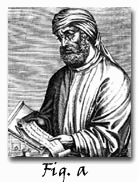 This motif of a pre-Christian or non-Christian god or man on a cross or cross-shaped is expounded upon by the Church fathers Tertullian (c. 160-c. 200) and Minucius Felix (2nd-3rd cents.). In his Apology(16), Tertullian remarks:
This motif of a pre-Christian or non-Christian god or man on a cross or cross-shaped is expounded upon by the Church fathers Tertullian (c. 160-c. 200) and Minucius Felix (2nd-3rd cents.). In his Apology(16), Tertullian remarks:
 This motif of a pre-Christian or non-Christian god or man on a cross or cross-shaped is expounded upon by the Church fathers Tertullian (c. 160-c. 200) and Minucius Felix (2nd-3rd cents.). In his Apology(16), Tertullian remarks:
This motif of a pre-Christian or non-Christian god or man on a cross or cross-shaped is expounded upon by the Church fathers Tertullian (c. 160-c. 200) and Minucius Felix (2nd-3rd cents.). In his Apology(16), Tertullian remarks:"We have shown before that your deities are derived from shapes modelled from the cross. But you also worship victories, for in your trophies the cross is the heart of the trophy. The camp religion of the Romans is all through a worship of the standards, a setting the standards above all gods. Well, as those images decking out the standards are ornaments of crosses. All those hangings of your standards and banners are robes of crosses." (Roberts, ANCL, 85)
The place where Tertullian had "shown before" his contentions about the Pagan gods being cross-shaped was in his work Ad Nationes (12), in a lengthy treatise which includes the following remarks:
"...The Heathens Themselves Made Much of Crosses in Sacred Things; Nay, Their Very Idols Were Formed on a Crucial [Crosslike] Frame."...your gods in their origin have proceeded from this hated cross... if you simply place a man with his arms and hands outstretched, you will make the general outline of a cross...." (Roberts, ANF, III, 122)
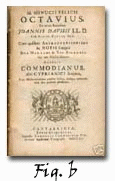 In his Octavius (29), Minucius echoes the same sentiment:
In his Octavius (29), Minucius echoes the same sentiment:"...The Egyptians certainly choose out a man for themselves whom they may worship... Crosses, moreover, we neither worship nor wish for. You, indeed, who consecrate gods of wood, adore wooden crosses perhaps as parts of your gods. For your very standards, as well as your banners, and flags of your camp, what else are they but crosses gilded and adorned? Your victorious trophies not only imitate the appearance of a simple cross, but also that of a man affixed to it." (Roberts, ANF, IV, 191)
In the same passage, Minucius states, "...crucis signum est, et cum homo porrectis manibus deum pura mente veneratur." (Felix, 66) To wit, "...the sign of the cross it is, also when a man stretching out his hands venerates God with a pure mind."
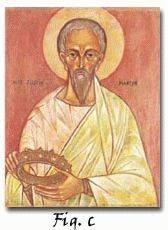 In his First Apology Church father Justin Martyr (c. 150) writes:
In his First Apology Church father Justin Martyr (c. 150) writes:"Chapter 21. Analogies to the history of Christ."And when we say also that the Word, who is the first-birth of God, was produced without sexual union, and that He, Jesus Christ, our Teacher, was crucified and died, and rose again, and ascended into heaven, we propound nothing different from what you believe regarding those whom you esteem sons of Jupiter..." (Roberts, ANF, I, 170)
It is evident that the Church fathers did not perceive the configuration of Christ on the cross to be anything unusual. Indeed, they insisted that the Pagans likewise worshipped gods on crosses or in "crucial frame," as Tertullian styles it. With such surprising declarations from early Christian authorities, we are justified in asking which of the "sons of Jupiter," i.e., the Greek and Roman gods, was thus depicted as "crucified?" What we discover is that both the cross and a deity or man on a cross were common sacred motifs long before the Christian era. In reality, there were many depictions of Pagan gods and goddesses in cruciform or in cross shape, with arms outstretched, a motif considered by the Church fathers to represent the "sign of the cross," such as concerns Moses, for example, at Exodus 17:11.  Regarding the repeated statements and reports about the reverential crosslike pose or "cruciform posture" by the Church fathers and elsewhere in Christendom, Rev. William W. Seymour remarks:
Regarding the repeated statements and reports about the reverential crosslike pose or "cruciform posture" by the Church fathers and elsewhere in Christendom, Rev. William W. Seymour remarks:
 Regarding the repeated statements and reports about the reverential crosslike pose or "cruciform posture" by the Church fathers and elsewhere in Christendom, Rev. William W. Seymour remarks:
Regarding the repeated statements and reports about the reverential crosslike pose or "cruciform posture" by the Church fathers and elsewhere in Christendom, Rev. William W. Seymour remarks:"Examples of this posture in prayer are found in the Catacombs...."We find that the ancient Egyptians used this posture in prayer, as is figured in the hieroglyphics on the obelisk before the Church of S. John Lateran at Rome. This also was the custom of the Romans... The Hebrews spread forth their hands before the Lord; in short, this posture in devotion we believe may be traced the world over..." (Seymour, 432-433)
In reality, non-Christian gods were represented in cruciform centuries before Christ was portrayed likewise; in fact, the first depiction of Jesus on a cross in art did not occur until the fifth century AD/CE. As stated by the Catholic Encyclopedia ("Cross and the Crucifix"):
"The sign of the cross, represented in its simplest form by a crossing of two lines at right angles, greatly antedates, in both the East and the West, the introduction of Christianity. It goes back to a very remote period of human civilization...."...It is also...a symbol of the sun...and seems to denote its daily rotation.... Cruciform objects have been found in Assyria.
The statutes of Kings Asurnazirpal and Sansirauman, now in the British Museum, have cruciform jewels about the neck.... Cruciform earrings were found by Father Delattre in Punic tombs at Carthage.
"Another symbol which has been connected with the cross is the ansated cross (ankh or crux ansata) of the ancient Egyptians.... From the earliest times also it appears among the hieroglyphic signs symbolic of life or of the living... perhaps it was originally, like the swastika, an astronomical sign. The ansated cross is found on many and various monuments of Egypt.... In later times the Egyptian Christians (Copts), attracted by its form, and perhaps by its symbolism, adopted it as the emblem of the cross..."...In the proto-Etruscan cemetery of Golasecca every tomb has a vase with a cross engraved on it....
"...On an ancient vase we see Prometheus bound to a beam which serves the purpose of a cross.... In the same way the rock to which Andromeda was fastened is called crux, or cross....
"...The Christian apologists, such as Tertullian (Apol., xvi; Ad. Nationes, xii) and Minucius Felix (Octavius, lx, xii, xxviii), felicitously replied to the pagan taunt by showing that their persecutors themselves adored cruciform objects. Such observations throw light on a peculiar fact of primitive Christian life, i.e. the almost total absence from Christian monuments of the period of persecutions of the plain, unadorned cross...
"...The early years of the fifth century are of the highest importance in this development, because it was then that the undisguised cross first appears.... But the fifth century marks the period when Christian art broke away from old fears, and, secure in its triumph, displayed before the world, now become Christian also, the sign of its redemption...."...The most ancient text we have relating to a carved cross dates from later than A.D. 362...."...Although in the fifth century the cross began to appear on public monuments, it was not for a century afterwards that the figure on the cross was shown; and not until the close of the fifth, or even the middle of the sixth century, did it appear without disguise...." (CE, IV, 517ff)
In its article entitled "Images," the Catholic Encyclopedia relates:
"...The first mentions of [Christian] crucifixes are in the sixth century.... The oldest crucifixes known are those on the wooden doors of St. Sabina at Rome and an ivory carving in the British Museum... Both are of the fifth century...." (CE, VII, 667)
As we can see, the cross was a sacred symbol, and cruciform objects were worn 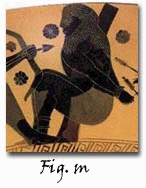 around the neck, long before the Christian era. One such cruciform figurine with a crucifix around its neck from Cyprus dates to the Chalcolithic Age (3900-2500 BCE). On a vase dating from around 350 BCE, we find a tortured Greek god Prometheus chained in cruciform, while another vase dating to the late sixth to early seventh centuries BCE depicts Prometheus on a stake or stauros, as the term is in Greek - the same word used in the New Testament to describe Christ's cross. Moreover, the mythical princess Andromeda too was portrayed essentially as having been crucified, as demonstrated by an image from Pompeii, which was destroyed in 79 AD/CE, several centuries before Christ was depicted on the cross in art. So too was the Egyptian cross or ankh a prevalent sacred symbol for millennia prior to the common era, being adopted as well by Egyptian Christians or Copts.
around the neck, long before the Christian era. One such cruciform figurine with a crucifix around its neck from Cyprus dates to the Chalcolithic Age (3900-2500 BCE). On a vase dating from around 350 BCE, we find a tortured Greek god Prometheus chained in cruciform, while another vase dating to the late sixth to early seventh centuries BCE depicts Prometheus on a stake or stauros, as the term is in Greek - the same word used in the New Testament to describe Christ's cross. Moreover, the mythical princess Andromeda too was portrayed essentially as having been crucified, as demonstrated by an image from Pompeii, which was destroyed in 79 AD/CE, several centuries before Christ was depicted on the cross in art. So too was the Egyptian cross or ankh a prevalent sacred symbol for millennia prior to the common era, being adopted as well by Egyptian Christians or Copts.
 around the neck, long before the Christian era. One such cruciform figurine with a crucifix around its neck from Cyprus dates to the Chalcolithic Age (3900-2500 BCE). On a vase dating from around 350 BCE, we find a tortured Greek god Prometheus chained in cruciform, while another vase dating to the late sixth to early seventh centuries BCE depicts Prometheus on a stake or stauros, as the term is in Greek - the same word used in the New Testament to describe Christ's cross. Moreover, the mythical princess Andromeda too was portrayed essentially as having been crucified, as demonstrated by an image from Pompeii, which was destroyed in 79 AD/CE, several centuries before Christ was depicted on the cross in art. So too was the Egyptian cross or ankh a prevalent sacred symbol for millennia prior to the common era, being adopted as well by Egyptian Christians or Copts.
around the neck, long before the Christian era. One such cruciform figurine with a crucifix around its neck from Cyprus dates to the Chalcolithic Age (3900-2500 BCE). On a vase dating from around 350 BCE, we find a tortured Greek god Prometheus chained in cruciform, while another vase dating to the late sixth to early seventh centuries BCE depicts Prometheus on a stake or stauros, as the term is in Greek - the same word used in the New Testament to describe Christ's cross. Moreover, the mythical princess Andromeda too was portrayed essentially as having been crucified, as demonstrated by an image from Pompeii, which was destroyed in 79 AD/CE, several centuries before Christ was depicted on the cross in art. So too was the Egyptian cross or ankh a prevalent sacred symbol for millennia prior to the common era, being adopted as well by Egyptian Christians or Copts.Horus and the Cross
In this regard, Osiris and Horus both were associated with and/or identified as a cross, such as the ankh, which, like the cross of Jesus, represents eternal life. 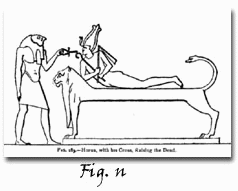 Horus is identified with the cross in several ways, using the ankh, for instance, to raise Osiris from the dead. Providing an example of the Church fathers' contention about gods with arms outstretched making the sign of the cross or being in "crucial frame," i.e., cruciform, Egyptologist Dr. Erik Hornung discusses Horus as the hawk "whose wings span the sky" (CGAE, 124) and "the ancient god of the heavens, whose wings spread over the whole earth" (VK, 59).
Horus is identified with the cross in several ways, using the ankh, for instance, to raise Osiris from the dead. Providing an example of the Church fathers' contention about gods with arms outstretched making the sign of the cross or being in "crucial frame," i.e., cruciform, Egyptologist Dr. Erik Hornung discusses Horus as the hawk "whose wings span the sky" (CGAE, 124) and "the ancient god of the heavens, whose wings spread over the whole earth" (VK, 59).  We find several other Egyptian gods and goddesses in this same cruciform pose, with arms and wings outstretched, including in tombs and on numerous coffins, serving as protection and assistance for a smooth passage into the afterlife, the same role as the cross on Christian coffins. Again, the early Christians considered figures with arms outstretched to be making the sign of the cross, and they compared Pagan gods in cruciform to Christ on the cross.
We find several other Egyptian gods and goddesses in this same cruciform pose, with arms and wings outstretched, including in tombs and on numerous coffins, serving as protection and assistance for a smooth passage into the afterlife, the same role as the cross on Christian coffins. Again, the early Christians considered figures with arms outstretched to be making the sign of the cross, and they compared Pagan gods in cruciform to Christ on the cross.
 Horus is identified with the cross in several ways, using the ankh, for instance, to raise Osiris from the dead. Providing an example of the Church fathers' contention about gods with arms outstretched making the sign of the cross or being in "crucial frame," i.e., cruciform, Egyptologist Dr. Erik Hornung discusses Horus as the hawk "whose wings span the sky" (CGAE, 124) and "the ancient god of the heavens, whose wings spread over the whole earth" (VK, 59).
Horus is identified with the cross in several ways, using the ankh, for instance, to raise Osiris from the dead. Providing an example of the Church fathers' contention about gods with arms outstretched making the sign of the cross or being in "crucial frame," i.e., cruciform, Egyptologist Dr. Erik Hornung discusses Horus as the hawk "whose wings span the sky" (CGAE, 124) and "the ancient god of the heavens, whose wings spread over the whole earth" (VK, 59).  We find several other Egyptian gods and goddesses in this same cruciform pose, with arms and wings outstretched, including in tombs and on numerous coffins, serving as protection and assistance for a smooth passage into the afterlife, the same role as the cross on Christian coffins. Again, the early Christians considered figures with arms outstretched to be making the sign of the cross, and they compared Pagan gods in cruciform to Christ on the cross.
We find several other Egyptian gods and goddesses in this same cruciform pose, with arms and wings outstretched, including in tombs and on numerous coffins, serving as protection and assistance for a smooth passage into the afterlife, the same role as the cross on Christian coffins. Again, the early Christians considered figures with arms outstretched to be making the sign of the cross, and they compared Pagan gods in cruciform to Christ on the cross.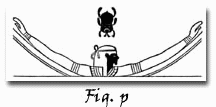 Horus as the hawk with his wings or arms outstretched reflects his role as the sun god "crossing over" the sky, as depicted in various hymns and Coffin Texts. As I say in Christ in Egypt (342), the significance of asserting the sun god to be "crucified" is not that his myth is imitated exactly in the gospel story but that he was a revered pre-Christian god "on a cross" and that this particular motif was adopted by those who created the Christian myth specifically because it was a popular and venerated theme.
Horus as the hawk with his wings or arms outstretched reflects his role as the sun god "crossing over" the sky, as depicted in various hymns and Coffin Texts. As I say in Christ in Egypt (342), the significance of asserting the sun god to be "crucified" is not that his myth is imitated exactly in the gospel story but that he was a revered pre-Christian god "on a cross" and that this particular motif was adopted by those who created the Christian myth specifically because it was a popular and venerated theme.
Moreover, in Christ in Egypt, I include an extensive discussion of a mysterious Egypto-Gnostic character named Horos, essentially the same name as "Horus" in Greek, although the two words are spelled slightly differently, the former with an omega and the latter with an omicron. Nevertheless, there is reason to suppose that the Gnostic figure of Horos and the Egyptian god Horus are at root one and the same. The Gnostic Horos not only is associated with but is also identified as "Stauros"—the Cross—again, the same Greek word used in the gospels to describe what Jesus was purportedly crucified upon. Indeed, in Christian writings Jesus is "often assimilated" to Horos-Stauros.
In describing the Gnostic character of Horos-Stauros, the Encyclopedia Britannica ("Valentinus") relates:
"A figure entirely peculiar to Valentinian Gnosticism is that of Horos (the Limiter). The name is perhaps an echo of the Egyptian Horus. The peculiar task of Horos is to separate the fallen aeons from the upper world of aeons. At the same time he becomes...a kind of world-creative power.... He is also called, curiously enough, Stauros (cross), and we frequently meet with references to the figure of Stauros. But we must not be in too great a hurry to conjecture that this is a Christian figure. Speculations about the Stauros are older than Christianity, and a Platonic conception may have been at work here. Plato had already stated that the world-soul revealed itself in the form of the letter Chi (X); by which he meant that figure described in the heavens by the intersecting orbits of the sun and the planetary ecliptic. Since through this double orbit all the movements of the heavenly powers are determined, so all "becoming" and all life depend on it, and thus we can understand the statement that the world-soul appears in the form of an X, or a cross. The cross can also stand for the wondrous aeon on whom depends the ordering and life of the world, and thus Horos-Stauros appears here as the first redeemer of Sophia from her passions, and as the orderer of the creation of the world which now begins. This explanation of Horos, moreover, is not a mere conjecture, but one branch of the Valentinian school, the Marcosians, have expressedly so explained this figure.... Naturally, then, the figure of Horos-Stauros was often in later days assimilated to that of the Christian Redeemer. (EB, 854 [Emph. added])
 Here we read that the name Horos is "perhaps an echo of the Egyptian Horus" and that "speculations about the Stauros are older than Christianity." We further learn that the ancient writer Plato (429-347 BCE) had described the "world-soul" in the shape of an X or cross and that this concept also represented the orbits of the sun and earth's ecliptic intersecting. Again, this Gnostic Horos-Stauros character with pre-Christian roots was so similar to the Christ figure that the two were frequently combined.
Here we read that the name Horos is "perhaps an echo of the Egyptian Horus" and that "speculations about the Stauros are older than Christianity." We further learn that the ancient writer Plato (429-347 BCE) had described the "world-soul" in the shape of an X or cross and that this concept also represented the orbits of the sun and earth's ecliptic intersecting. Again, this Gnostic Horos-Stauros character with pre-Christian roots was so similar to the Christ figure that the two were frequently combined.Plato's World Soul and Just Man Crucified
In his role as the sun crossing over the sky and as the apparent origin of the Horos-Stauros character, Horus has been compared to Plato's world-soul impressed upon a cross in the heavens, as found in the Timaeus (36bc). (Plato, 49) This Platonic figure in turn was commonly taken to be a "foreshadowing" of the Christ character and cross. As theologian Rev. Dr. Hugo Rahner states:
"...Adapting an old Pythagorean notion, Plato had written in the Timaeus of the world soul revealed in the celestial X; to the early Christian this was a pagan imitation of the world-building crucified Logos who encompasses the cosmos and causes it to revolve around the mystery of the Cross." (Campbell, 372)
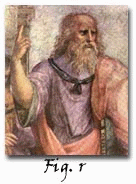 One of these early Christians who saw the Cross and Son of God revealed in Plato's writing was Justin Martyr, who in his First Apology (60.1), in a section entitled "Plato's Doctrine of the Cross," remarked:
One of these early Christians who saw the Cross and Son of God revealed in Plato's writing was Justin Martyr, who in his First Apology (60.1), in a section entitled "Plato's Doctrine of the Cross," remarked:"And the physiological discussion concerning the Son of God in the Timæus of Plato, where he says, 'He placed him crosswise in the universe," he borrowed in like manner from Moses...'" (Roberts, ANF, I, 183; Justin/Gildersleeve, 55)
Commenting on this interpretation, Dr. Eric Francis Osborn states, "The supremacy of divine love in creation leads Justin to attribute to Plato the concept of the cosmic cross." (Osborn, 51)  Justin's remark about Moses being the originator of the cosmic cross comes from the early Church fathers' interpretation of Numbers 21:6-9, in which Moses is said to raise up a bronze serpent, asserted to be a "type of cross." In consideration of the debate as to Moses's historicity and when exactly the Old Testament texts were written down first, the contention that the biblical writers possessed these or other spiritual notions before other cultures is unfounded, particularly in view of the antiquity of the Egyptian civilization and the abundance of spiritual concepts there.
Justin's remark about Moses being the originator of the cosmic cross comes from the early Church fathers' interpretation of Numbers 21:6-9, in which Moses is said to raise up a bronze serpent, asserted to be a "type of cross." In consideration of the debate as to Moses's historicity and when exactly the Old Testament texts were written down first, the contention that the biblical writers possessed these or other spiritual notions before other cultures is unfounded, particularly in view of the antiquity of the Egyptian civilization and the abundance of spiritual concepts there.
 Justin's remark about Moses being the originator of the cosmic cross comes from the early Church fathers' interpretation of Numbers 21:6-9, in which Moses is said to raise up a bronze serpent, asserted to be a "type of cross." In consideration of the debate as to Moses's historicity and when exactly the Old Testament texts were written down first, the contention that the biblical writers possessed these or other spiritual notions before other cultures is unfounded, particularly in view of the antiquity of the Egyptian civilization and the abundance of spiritual concepts there.
Justin's remark about Moses being the originator of the cosmic cross comes from the early Church fathers' interpretation of Numbers 21:6-9, in which Moses is said to raise up a bronze serpent, asserted to be a "type of cross." In consideration of the debate as to Moses's historicity and when exactly the Old Testament texts were written down first, the contention that the biblical writers possessed these or other spiritual notions before other cultures is unfounded, particularly in view of the antiquity of the Egyptian civilization and the abundance of spiritual concepts there.
In any event, centuries before the common era Plato also discussed a "just man" who is "crucified" (Republic 361d), as related by Pope Benedict XVI (Cardinal Ratzinger):
"...according to Plato the truly just man must be misunderstood and persecuted in this world; indeed, Plato goes so far as to write: 'They will say that our just man will be scourged, racked, fettered, will have his eyes burned out, and at last, after all manner of suffering will be crucified.' This passage, written four hundred years before Christ, is always bound to move a Christian deeply." (Ratzinger, 353)
The Pope uses the translation of Plato by Dr. A.D. Lindsay, who specifically renders the Greek as "crucified" in describing the fate of the "just man." This Platonic passage, in fact, much resembles that found at Isaiah 53:4-1 and, along with that OT "messianic prophecy," likely was used as a blueprint in the creation of the Christ character. Again, in Platonic philosophy, the "world soul" or "divine Son of God," as Justin interprets it, is impressed upon a cross in the vault of heaven, representing, as we have seen, the sun crossing over the ecliptic, which was likewise the role not only of Horus in transit across the sky but also of the Gnostic Horos-Stauros, another "cosmic cross."
Osiris and the Djed Pillar

 As a Platonic ideal, the cosmic cross/stauros precedes the Christian era by centuries; yet, the cross supposedly only gained significance with Jesus's alleged death upon it. In fact, the cross's purpose as bestower of salvation and eternal life already existed as a spiritual concept long before the common era, in Egypt for one. Indeed, Osiris's depiction on or as the djed pillar - surrounded by the two sisters or "the Merti" (Budge, 429), much like Christ on the cross with the three Marys at his feet (Jn 19:25)—served as "sin removal," as related in Christ in Egypt (351):
As a Platonic ideal, the cosmic cross/stauros precedes the Christian era by centuries; yet, the cross supposedly only gained significance with Jesus's alleged death upon it. In fact, the cross's purpose as bestower of salvation and eternal life already existed as a spiritual concept long before the common era, in Egypt for one. Indeed, Osiris's depiction on or as the djed pillar - surrounded by the two sisters or "the Merti" (Budge, 429), much like Christ on the cross with the three Marys at his feet (Jn 19:25)—served as "sin removal," as related in Christ in Egypt (351):"...the erection of the djed cross during the celebration also apparently took the place of human sacrifice, which was designed to propitiate the god or God in order to remove sins and bring about continuity of the community as a whole."
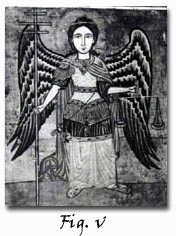 The correlation between Osiris's pillar and the cross of Jesus was obvious enough to the Egyptian Christians or Copts for them to depict Archangel Michael, for example, holding a "djed cross" in his right hand.
The correlation between Osiris's pillar and the cross of Jesus was obvious enough to the Egyptian Christians or Copts for them to depict Archangel Michael, for example, holding a "djed cross" in his right hand.
As further stated in CIE (365), in addition to pre-Christian texts depicting the "crucified man in space," we also possess various Egypto-Christian artifacts connecting Jesus with both Osiris and Horus, including Gnostic gems. As another example, in Ancient Christian Mage: Coptic Texts of Ritual Power, Drs. Marvin W. Meyer and Richard Smith report on a crucifix in the Coptic Museum in Old Cairo "with the crucified figure of Jesus together with a falcon (Horus)." This artifact demonstrates that identifying Horus with the crucified Jesus occurred even in antiquity.
As revealed in my books Christ in Egypt and Suns of God, there is much more to the subject of Pagan gods and goddesses on a cross or in cruciform, serving as crucifixes. The images and descriptions of deities in cruciform include Osiris, Isis and Horus, and the answer to the question of whether or not Horus was ever associated with the cross and depicted on a cross or in cruciform must be a resounding yes. If other gods were shown on a cross or in cruciform, or associated otherwise with a sacred cross, then Christ's depiction on a cross is not unique. If the Pagan personified savior-cross existed first, the whole notion of Christ's redeeming power through the cross becomes derivative. Rather than representing "history," it is more probable that Christ's "crucifixion" constitutes a mythical motif created in order to associate him with the already revered cross and image of a divine figure in cruciform. We must therefore conclude that the figure of Christ on a cross or in the shape of a cross is a johnny-come-lately in the world of religious iconography, and the story of the crucifixion appears more likely a contrivance based on this important imagery, as well as on Jewish "messianic prophecies" or blueprints, instead of an improbable "historical" tale. Indeed, the crucifixion reveals itself to be another pre-Christian mythical motif with a largely astrotheological meaning.
Along with this interesting evidence concerning the profound importance of the sacred cross in pre-Christian religion, as well as its association and identification with Egyptian gods, we find another "Christian" motif in Egypt, with Horus represented on the cross at the vernal equinox between two "thieves" in a pre-Christian artifact. For much more information on this fascinating subject, see Christ in Egypt: The Horus-Jesus Connection.
Sources
"1000 Years of History," www.limassollink.com/history.php
"Herakles & Prometheus," www.theoi.com/Gallery/T21.4.html
Budge, Ernest Alfred Wallis, An Egyptian Hieroglyphic Dictionary, v. 1, Dover Publications, NY, 1978.
Campbell, Joseph, ed., The Mysteries: Papers from the Eranos Yearbooks, Bollingen Series XXX, Princeton University Press, 1979.
Catholic Encyclopedia, IV, ed. Charles George Herbermann, The Encyclopedia Press, 1913.
--VII, ed. Charles George Herbermann, The Encyclopedia Press, 1913.
Corbelli, Judith A., The Art of Death in Graeco-Roman Egypt, Osprey Publishing, 2006.
Doane, Thomas, Bible Myths and Their Parallels in Other Religions, The Truth Seeker, 1882.
Encyclopedia Britannica, XXVII, The Encyclopedia Britannica Company, NY, 1910.
Faulkner, Raymond, The Egyptian Book of the Dead, Chronicle Books, San Francisco, 1998.
Felix, Minucius, Octavius, ed. Gilles Quispel, E.J. Brill, Leiden, 1973.
Hornung, Erik, Conceptions of God in Ancient Egypt, tr. John Baine, Cornell University Press, NY, 1982.
--The Valley of the Kings: Horizon of Eternity, tr. David Warburton, Timken Publishers, NY, 1990.
Justin Martyr, The Apologies of, ed. Basil L. Gildersleeve, Harper & Brothers Publishers, NY, 1877.
Kamil, Jill, Christianity in the Land of the Pharaohs: The Coptic Orthodox Church, Routledge, 2002.
Lundy, John P., Monumental Christianity, or the Art and Symbolism of the Primitive Church, J.W. Bouton, NY, 1876.
Maitland, Charles, The Church in the Catacombs: A Description of the Primitive Church of Rome, Longman, Brown, Green and Longmans, London, 1846.
Meyer, Marvin W. and Smith, Richard, Ancient Christian Mage: Coptic Texts of Ritual Power, Princeton University Press, 1999.
Murdock, D.M., Christ in Egypt: The Horus-Jesus Connection, Stellar House Publishing, Seattle, 2009.
Osborn, Eric Francis, Justin Martyr, J.C.B. Mohr/Siebeck, Tubingen, 1973.
Plato, Timaeus and Critias, tr. Desmond Lee, Penguin Books, 1971.
Ratzinger, Joseph Cardinal, Introduction to Christianity, Ignatius Press, 2004.
Roberts, Alexander, Ante-Nicene Christian Library, XI, T&T Clark, Edinburgh, 1869.
--Ante-Nicene Fathers, I, The Christian Literature Publishing Co., Buffalo, 1885.
--Ante-Nicene Fathers, III, Charles Scribner's Sons, NY, 1903.
--Ante-Nicene Fathers, IV, Charles Scribner's Sons, NY, 1926.
Seymour, William Wood, The Cross in Tradition, History and Art, G.P. Putnam's Sons, NY/London, 1898.
Sharpe, Samuel, Egyptian Antiquities in the British Museum, John Russell Smith, London, 1862.
Wilkinson, J. Gardner, The Manner and Customs of the Ancient Egyptians, I, John Murray, London, 1847.
"Herakles & Prometheus," www.theoi.com/Gallery/T21.4.html
Budge, Ernest Alfred Wallis, An Egyptian Hieroglyphic Dictionary, v. 1, Dover Publications, NY, 1978.
Campbell, Joseph, ed., The Mysteries: Papers from the Eranos Yearbooks, Bollingen Series XXX, Princeton University Press, 1979.
Catholic Encyclopedia, IV, ed. Charles George Herbermann, The Encyclopedia Press, 1913.
--VII, ed. Charles George Herbermann, The Encyclopedia Press, 1913.
Corbelli, Judith A., The Art of Death in Graeco-Roman Egypt, Osprey Publishing, 2006.
Doane, Thomas, Bible Myths and Their Parallels in Other Religions, The Truth Seeker, 1882.
Encyclopedia Britannica, XXVII, The Encyclopedia Britannica Company, NY, 1910.
Faulkner, Raymond, The Egyptian Book of the Dead, Chronicle Books, San Francisco, 1998.
Felix, Minucius, Octavius, ed. Gilles Quispel, E.J. Brill, Leiden, 1973.
Hornung, Erik, Conceptions of God in Ancient Egypt, tr. John Baine, Cornell University Press, NY, 1982.
--The Valley of the Kings: Horizon of Eternity, tr. David Warburton, Timken Publishers, NY, 1990.
Justin Martyr, The Apologies of, ed. Basil L. Gildersleeve, Harper & Brothers Publishers, NY, 1877.
Kamil, Jill, Christianity in the Land of the Pharaohs: The Coptic Orthodox Church, Routledge, 2002.
Lundy, John P., Monumental Christianity, or the Art and Symbolism of the Primitive Church, J.W. Bouton, NY, 1876.
Maitland, Charles, The Church in the Catacombs: A Description of the Primitive Church of Rome, Longman, Brown, Green and Longmans, London, 1846.
Meyer, Marvin W. and Smith, Richard, Ancient Christian Mage: Coptic Texts of Ritual Power, Princeton University Press, 1999.
Murdock, D.M., Christ in Egypt: The Horus-Jesus Connection, Stellar House Publishing, Seattle, 2009.
Osborn, Eric Francis, Justin Martyr, J.C.B. Mohr/Siebeck, Tubingen, 1973.
Plato, Timaeus and Critias, tr. Desmond Lee, Penguin Books, 1971.
Ratzinger, Joseph Cardinal, Introduction to Christianity, Ignatius Press, 2004.
Roberts, Alexander, Ante-Nicene Christian Library, XI, T&T Clark, Edinburgh, 1869.
--Ante-Nicene Fathers, I, The Christian Literature Publishing Co., Buffalo, 1885.
--Ante-Nicene Fathers, III, Charles Scribner's Sons, NY, 1903.
--Ante-Nicene Fathers, IV, Charles Scribner's Sons, NY, 1926.
Seymour, William Wood, The Cross in Tradition, History and Art, G.P. Putnam's Sons, NY/London, 1898.
Sharpe, Samuel, Egyptian Antiquities in the British Museum, John Russell Smith, London, 1862.
Wilkinson, J. Gardner, The Manner and Customs of the Ancient Egyptians, I, John Murray, London, 1847.
Illustrations
a. Tertullian
b. The Octavius of Minucius Felix
c. Justin Martyr
d. Cruciform prayer posture of deceased Christian in the catacombs. (Seymour, 433)
e. Hellenized Egyptian funerary stela from Kom Abu-Billo/Terenuthis, with Horus hawk. 3rd-4th cent. AD/CE (Kamil, 153; Corbelli, 39)
f. Human in cruciform with cross around neck from Cyprus, Chalcolithic period (3900-2500 BCE), www.limassollink.com/
g. The Shari in Egypt wearing crosses, possibly Assyrians, c. 15th cent. BCE. (Wilkinson, I, 365, 375ff)
h. Crosses on the bottoms of ossuary-vases from the cemetery at Golasecca, Italy. (Seymour, 25)
i. Prometheus crucified using chains on a Greek vase, c. 350. BCE, www.theoi.com/Gallery/T21.4.html
j. Andromeda crucified using chains in a wall painting from Pompeii, c. 79 AD/CE, www.uwm.edu/Course/mythology/0800/underworld.htm
k. Early Christian crucifix from the catacombs, in a manuscript from the sixth century. (Seymour, 172)
l. Crucifixion scene from the Santa Sabina Church, Rome, 5th cent.
m. Prometheus bound to a wooden stake or stauros, i.e., a cross, on a Greek vase, c. late sixth to early seventh cents. BCE, www.theoi.com/Gallery/T21.5.html
n. Horus using Egyptian cross to raise Osiris. (Lundy, 403)
o. Winged goddess (Isis) in cruciform on King Tut's sarcophagus.
p. Horus with arms outstretched in vault of heaven, from Samuel Sharpe's Egyptian Antiquities in the British Museum (143). This image was originally on a papyrus and is here and in Christ in Egypt depicted upside down for purposes of more readily illustrating the point.
q. Plato's world soul forming a cross of the solar and planetary orbits and ecliptic.
r. Plato
s. Moses raising up the "brazen serpent" or snake made of bronze, shaped like a cross. (Seymour, 54)
t. Osiris as personified djed pillar holding the sun, surrounded by the two sisters Isis and Nephthys - called the Merti - found in the Egyptian Book of the Dead, Ani Papyrus, plate 1, c. 13th-15th cents. BCE.
u. Christ on the cross, surrounded by the three Marys, per John 19:25, www.knowjesuschrist.org/prayers.html.
v. Archangel Michael holding a djed cross in a Coptic painting, 18th cent. (Kamil, 156)
b. The Octavius of Minucius Felix
c. Justin Martyr
d. Cruciform prayer posture of deceased Christian in the catacombs. (Seymour, 433)
e. Hellenized Egyptian funerary stela from Kom Abu-Billo/Terenuthis, with Horus hawk. 3rd-4th cent. AD/CE (Kamil, 153; Corbelli, 39)
f. Human in cruciform with cross around neck from Cyprus, Chalcolithic period (3900-2500 BCE), www.limassollink.com/
g. The Shari in Egypt wearing crosses, possibly Assyrians, c. 15th cent. BCE. (Wilkinson, I, 365, 375ff)
h. Crosses on the bottoms of ossuary-vases from the cemetery at Golasecca, Italy. (Seymour, 25)
i. Prometheus crucified using chains on a Greek vase, c. 350. BCE, www.theoi.com/Gallery/T21.4.html
j. Andromeda crucified using chains in a wall painting from Pompeii, c. 79 AD/CE, www.uwm.edu/Course/mythology/0800/underworld.htm
k. Early Christian crucifix from the catacombs, in a manuscript from the sixth century. (Seymour, 172)
l. Crucifixion scene from the Santa Sabina Church, Rome, 5th cent.
m. Prometheus bound to a wooden stake or stauros, i.e., a cross, on a Greek vase, c. late sixth to early seventh cents. BCE, www.theoi.com/Gallery/T21.5.html
n. Horus using Egyptian cross to raise Osiris. (Lundy, 403)
o. Winged goddess (Isis) in cruciform on King Tut's sarcophagus.
p. Horus with arms outstretched in vault of heaven, from Samuel Sharpe's Egyptian Antiquities in the British Museum (143). This image was originally on a papyrus and is here and in Christ in Egypt depicted upside down for purposes of more readily illustrating the point.
q. Plato's world soul forming a cross of the solar and planetary orbits and ecliptic.
r. Plato
s. Moses raising up the "brazen serpent" or snake made of bronze, shaped like a cross. (Seymour, 54)
t. Osiris as personified djed pillar holding the sun, surrounded by the two sisters Isis and Nephthys - called the Merti - found in the Egyptian Book of the Dead, Ani Papyrus, plate 1, c. 13th-15th cents. BCE.
u. Christ on the cross, surrounded by the three Marys, per John 19:25, www.knowjesuschrist.org/prayers.html.
v. Archangel Michael holding a djed cross in a Coptic painting, 18th cent. (Kamil, 156)


Δεν υπάρχουν σχόλια:
Δημοσίευση σχολίου